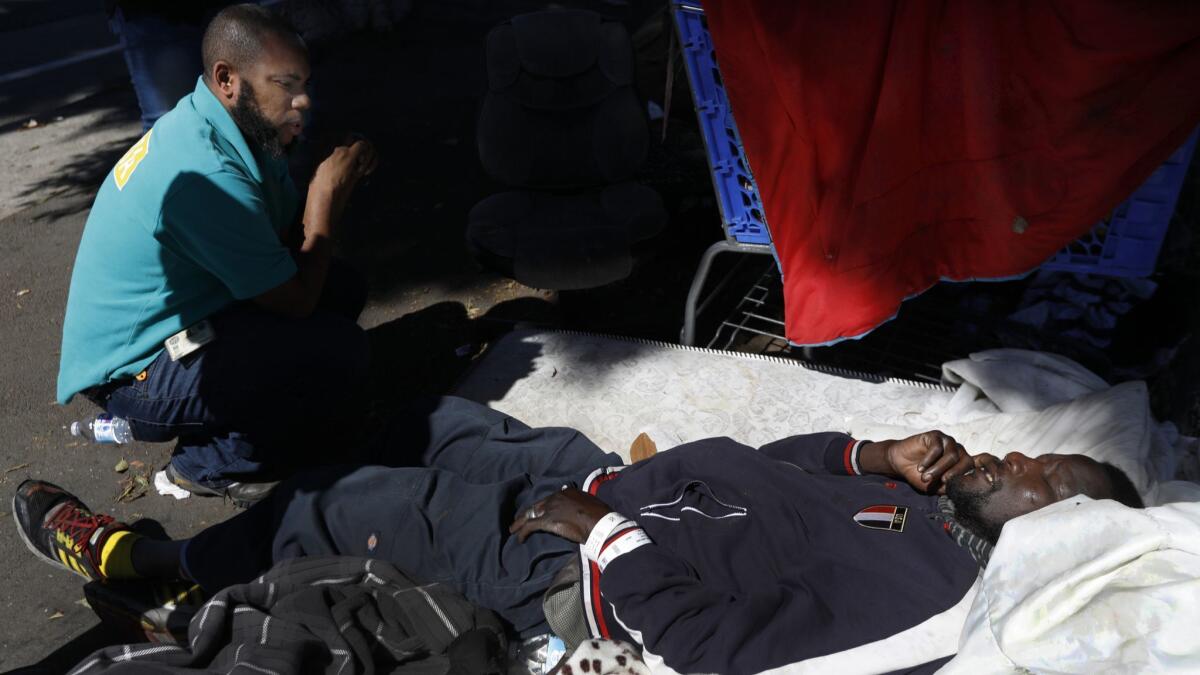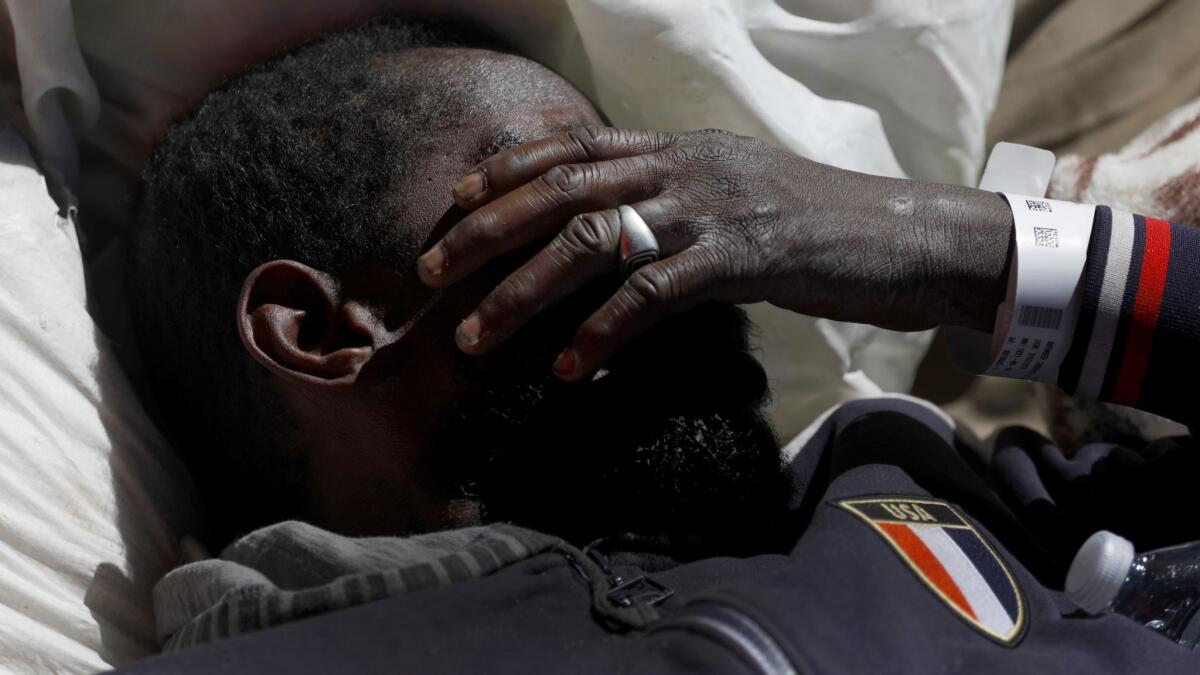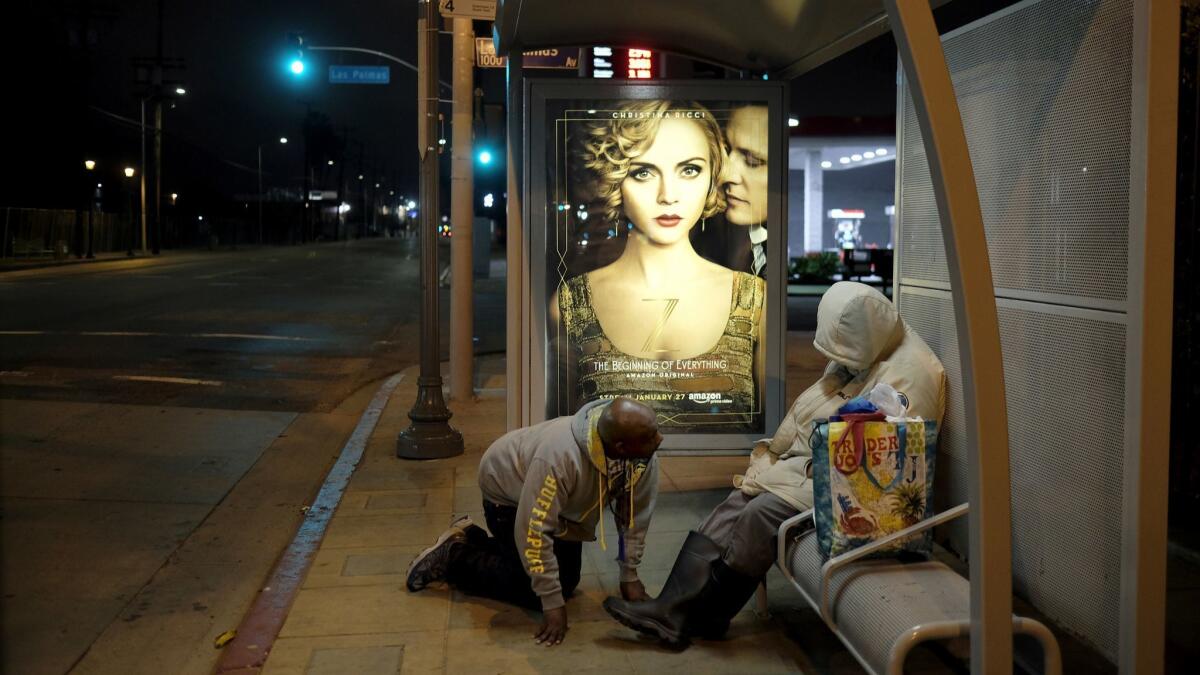Should California expand what it means to be ‘gravely disabled’?

When Gov. Ronald Reagan signed the Mental Health Act of 1967, the legislation signaled a new era in the treatment of mentally ill Californians.
Also known as the Lanterman-Petris-Short Act, the law recognized that not everyone with a mental illness needed to be confined to a state-run psychiatric hospital. Section 5150 established guidelines for the detention of “mentally disordered persons” up to 72 hours for assessment and treatment.
The 1967 law has become a valuable tool for law enforcement agencies and mental health professionals dealing with people living on the street.
But with homelessness surging throughout California, some argue that the 5150 provision needs to be expanded, giving authorities wider latitude in deciding when someone should be removed from the streets.
Legislators in Sacramento will consider this question in the coming months as they debate Assembly Bill 1971. The measure, introduced by Assembly members Miguel Santiago (D-Los Angeles) and Laura Friedman (D-Glendale), would include those who are unable to seek treatment for serious medical conditions.
In 2017, more than 800 homeless people died in L.A. County from medical conditions that are considered to be preventable, records show. There is no estimating who among these were mentally ill, but it is acknowledged that mentally ill people are least likely to perceive how dangerous and unhealthy their living environments are.
“Individuals are falling through the cracks,” said Eric Matos, a deputy for Los Angeles County Supervisor Kathryn Barger, who co-sponsored a county motion supporting the bill.
Under the current law, people can be detained if they are deemed to be a danger to themselves or others, or are “gravely disabled,” which is defined primarily as being unable to provide food, clothing or shelter for themselves, or to understand the nature and severity of their illness. Such holds can be extended up to a month and eventually include conservatorship for more than a year.
But Matos describes a scenario in which people with a life-threatening medical condition could not be helped under the law because they are not considered gravely disabled. They scrounge for food in a trash bin, sleep under an overpass and rummage for clothes at a thrift store.
“What we’re trying to do is change what initiates a conservatorship to include getting medical treatment,” Matos said.
Proponents see the measure as an extra tool for law enforcement agencies, mental health professionals and outreach workers when they find someone who’s sick or injured.
“I actually don’t see this as an expansion of grave disability but a clarification,” Dr. Jonathan Sherin, L.A. County’s mental health director, told the Board of Supervisors in January. At their request, Sherin helped develop the language that would become the basis for AB 1971.
“It’s a red flag for us to recognize,” Sherin said. “It’s an objective measure that judges will be able to use and properly apply by considering the data when they’re making a determination about whether someone is gravely disabled.”
The Los Angeles County Council of the National Alliance on Mental Illness supports the additional language.
Critics, however, argue that without proper resources and support such as housing and case management, medical treatment will be ineffective.
“To sponsor legislation to amend Lanterman-Petris-Short so that being gravely disabled includes not seeking medical treatment imagines that there is somewhere to go and somewhere to stay,” said Supervisor Shelia Kuehl, who cast the board’s lone vote opposing the county motion.
Without housing and long-term assistance, she argued, the new law will not be enough to keep people safe.
Kuehl also raised a concern over “forced treatment.”
“The medical establishment has made decisions for people, taking away their rights to make decisions for themselves in the past in some very egregious ways,” she said, making a case for further measures that would protect the autonomy and civil rights of people who might qualify for this hold.
For some homeless advocates, it’s a delicate balance.
“Our position has been in the middle,” said Megan Hustings, with the National Coalition of the Homeless. “We understand there are some people who are a danger to themselves and others and the community needs to respond, but the idea of involuntary or forced action is difficult when we’re in a massive affordable-housing crisis.”
::
When the Lanterman-Petris-Short Act went into effect in 1972, it was one of the first attempts in the country to wrestle mental-health care away from the often cruel and antiquated practice of incarcerating the mentally ill, indefinitely and involuntarily.
In the decades since, the results have been mixed.
The goal of establishing county facilities throughout the state for treating the mentally ill was never realized. Meager funding from the state and local government limited treatment options, and mentally ill people often ended up on the street.
Attempts have been made to improve the legislation, notably Laura’s Law in 2002, which allowed for court-ordered outpatient treatment. And with voters approving Measure H and Proposition HHH, additional resources for mental-health care and social services are becoming available.
But treating the mentally ill on the street often defies the best intentions.
With more than 50,000 people homeless now in Los Angeles County — and an estimated 30% of them mentally ill — authorities can find themselves overwhelmed.
In 2015, according to Lt. Brian Bixler, who runs the Los Angeles Police Department’s crisis response section, the LAPD had eight crisis teams on the street and wrote 3,994 holds. Two years later, with the addition of nine more teams, 6,646 holds were written.
At that, Bixler said, “we cannot respond to all the calls. We are simply too busy.”

Outreach workers, who are often the first to find someone who is either suicidal or in the midst of a psychotic episode, must decide whether to call for help. They say the process — a forcible dislocation — can be worse than doing nothing at all.
It can jeopardize the rapport and trust they might have established with clients, they say, and can result in the loss of a tent or other possessions. At worst, outreach workers might lose contact with their client, terminating a relationship that’s critical to providing help.
They also know that paramedics won’t transfer someone who refuses treatment. Police agencies can walk away if the individual seems nonthreatening, and hospitals can discharge patients after a medical assessment and before a psychiatric assessment can be made.
For Anthony Ruffin, who has worked in homeless services for 20 years, the medical component represents the weakest link in the system, especially if the individual is taken to a private facility that must absorb cost of treatment.

When a candidate for a 5150 hold is brought into a hospital, a room must be cleared, security provided, and the medical staff must conduct a physical examination. Medical tests, ranging from blood work and drug screenings to X-rays and CT scans, are typically conducted before the candidate is assessed by a psychiatrist.
Intoxicated patients must be sober. Diabetic patients must have a reasonable blood sugar level. Injuries — cuts or broken bones — must be attended to. And if the patient is homeless, a social worker is brought in.
Hospitals also receive their share of “frequent fliers,” who claim to be suicidal for the purpose of getting off the street for the night and tie up rooms and bed space that would go to other patients.
Once the patient has been medically cleared and accepted for a hold — a process that at best takes up to five hours — the hospital must find a bed in a psychiatric hospital. Doctors say some of these facilities may request additional medical testing, which is often interpreted as a stalling tactic.
“Once the doctors determine that the hold is legitimate, the facility is committed to providing mental health services,” Ruffin said. “That could take anywhere from a day to eight months. During this time, who is following up with the client in the hospital, working with the doctors and making sure the person doesn’t end up back on the street untreated?”
Adding medical treatment to the 5150 criteria would likely increase the costs and bring additional pressure to an already overworked medical system, he maintains.
Patients with high blood pressure, congestive heart failure or diabetes require a comprehensive treatment plan. Few diseases can be remedied in the course of a few days, or as in the case of a mental illness, eased with medications.
“It’s the follow-through that matters most,” Ruffin said. “This is where we have failed in the past. Someone is treated for a year or so, and then as soon as they get out of the system, they fall back into old patterns.”
Despite this, expanding the criteria for 5150 is the humane thing to do, said Ruffin, who has watched clients die on the streets despite his efforts to get them help. They simply turned down his offer of getting medical treatment, he said.
“The new bill isn’t perfect. It will need to be refined, but it gives outreach workers more teeth to get a patient into a hospital, and it will force hospitals to treat the patients,” Ruffin said. He also hopes that funding provided by Measure H will create specialized outreach teams who stay with clients in the hospital and oversee their discharge plan.
It is critical as well, he said, that the final version of AB 1971 focus on only the most vulnerable — “the bottom 1% of the homeless population.”
“You can’t have teams using this new law to lock up everybody,” Ruffin said.
During the debate at the county Board of Supervisors, mental health director Sherin spoke to the larger need for the law.
“In a perfect world, we would have a more connected society,” he said. “We wouldn’t have a need. We’d have less fear, less judgment and more civic duty that would connect us and minimize the amount of involuntary treatment that we require.”
Twitter: @tcurwen
More to Read
Sign up for Essential California
The most important California stories and recommendations in your inbox every morning.
You may occasionally receive promotional content from the Los Angeles Times.











